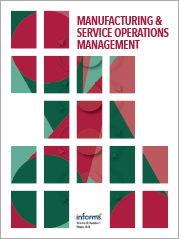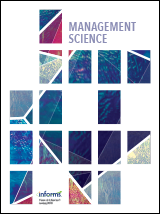Academic articles
Practitioner articles
Working papers
Books
Book chapters
Case studies
Other publications
Subject(s)
Economics, politics and business environment; Strategy and general management; Technology, R&D management
Keyword(s)
bundling, tying, competition, innovation, cloud computing
JEL Code(s)
K21, L12, L41
Pages
6
Journal Pages
211–216
Subject(s)
Management sciences, decision sciences and quantitative methods
Keyword(s)
Service operations, rational inattention, strategic customers, rational queueing, information costs, system throughput, social welfare
Problem description: Classical models of queueing systems with rational and strategic customers assume queues to be either fully visible or invisible while service parameters are known with certainty. In practice, however, people only have “partial information” on the service environment in the sense that they are not able to fully discern prevalent uncertainties. This is because assessing possible delays and rewards is costly as it requires time, attention, and cognitive capacity which are all limited. On the other hand, people are also adaptive and endogenously respond to information frictions. Methodology: We develop an equilibrium model for a single-server queueing system with customers having limited attention. Following the theory of rational inattention, we assume that customers optimize their learning strategies by deciding the type and amount of information to acquire and act accordingly while internalizing the associated costs. Results: We establish the existence and uniqueness of a customer equilibrium and delineate the impact of service characteristics and information costs. We numerically show that when customers allocate their attention to learn uncertain queue length, limited attention of customers improves throughput in a congested system that customers value reasonably highly, while it can be detrimental for less popular services that customers deem rather unrewarding. This is also reflected in social welfare if the firm's profit margin is high enough, although customer welfare always suffers from information costs. Managerial implications: Our results shed light on optimal information provision and physical design strategies of service firms and social planners by identifying service settings where they should be most cautious for customers' limited attention. Academic/practical relevance: We propose a microfounded framework for strategic customer behavior in queues that links beliefs, rewards, and information costs. It offers a holistic perspective on the impact of information prevalence (and information frictions) on operational performance and can be extended to analyze richer customer behavior and complex queue structures, rendering it a valuable tool for service design.
© 2021 INFORMS
Volume
25
Journal Pages
266–287
ISSN (Online)
1526–5498
ISSN (Print)
1523-4614
Subject(s)
Economics, politics and business environment; Information technology and systems
Keyword(s)
digital government, cyber risk, cyber crisis management, network governance, resilience, electronic identity, estonia
Volume
40
Journal Pages
101781
Subject(s)
Human resources management/organizational behavior
Keyword(s)
negotiation, offer, impasses, numeric precision, mimicry
Negotiations can end with a successful deal or with an impasse. To minimize the impasse risk, how assertive and precise should negotiators’ first offers be? Recent studies diverge in their findings as to the advantages and disadvantages of making round vs. precise offers. Based on over 25 million eBay negotiations, the present research establishes correlational evidence that buyer offers at round percentages of the seller’s list price—for instance, exactly 50% (75%, 90%, etc.)—coincide with a markedly smaller impasse risk than offers just above (e.g., 50.1%) or just below (49.9%) these round percentages. We also find that buyers who mimic sellers’ list price precision (e.g., offering $89.95 for a product listed at $99.99) and exact price endings ($30.13 for a list price of $40.13) incur markedly smaller impasse risks. Our findings show that the effectiveness of buyers’ round vs. precise offers depends on the roundness of the seller’s list price, therefore extending previous research that focused on offer precision without taking opponents’ list price into account. Multiple robustness checks—examining negotiators’ experience, price levels, product demand, etc.—corroborate the reported findings. We discuss promising avenues for future research on the interpersonal effects of offer precision and priceending mimicry.
With permission of Elsevier
Volume
94
Journal Pages
102584
Subject(s)
Management sciences, decision sciences and quantitative methods; Technology, R&D management
Keyword(s)
decertification, innovation, quality management, standards
JEL Code(s)
L15, O32, L25.
The literature on quality-management standards has generally focused on the drivers, motivations, and performance effects of adopting such standards. Yet the last decade has witnessed a substantial degree of decertification behavior, as organizations have increasingly decided to voluntarily withdraw from quality-management standards by not recertifying. While the drivers of the decision to initially adopt quality-management standards have been extensively studied, the drivers of the decision to decertify have received scant scholarly attention. We argue that innovative organizations are generally prone to retaining quality-management certification and thus exhibit a tendency to not abandon certification; however, radically-innovative organizations are more prone than incrementally-innovative organizations to discontinue quality-management standards and thereby exhibit a tendency to withdraw from quality certification. We compile World Bank data surveying facilities based in 50 countries and 103 industrial sectors across the 2003 to 2017 period. Taking advantage of the data’s panel properties yields a dataset composed of up to 1,755 facility-level observations of recertification decisions for empirical analysis. Our empirical testing employs a probit estimation technique that accounts for the appropriate fixed effects and generates results that support our theoretical priors regarding decertification behavior.
With permission of Elsevier
Volume
52
Journal Pages
104647
Subject(s)
Management sciences, decision sciences and quantitative methods; Product and operations management; Technology, R&D management
Keyword(s)
Data, machine learning, data product, pricing, incentives, contracting
This paper explores how firms that lack expertise in machine learning (ML) can leverage the so-called AI Flywheel effect. This effect designates a virtuous cycle by which, as an ML product is adopted and new user data are fed back to the algorithm, the product improves, enabling further adoptions. However, managing this feedback loop is difficult, especially when the algorithm is contracted out. Indeed, the additional data that the AI Flywheel effect generates may change the provider's incentives to improve the algorithm over time. We formalize this problem in a simple two-period moral hazard framework that captures the main dynamics among ML, data acquisition, pricing, and contracting. We find that the firm's decisions crucially depend on how the amount of data on which the machine is trained interacts with the provider's effort. If this effort has a more (less) significant impact on accuracy for larger volumes of data, the firm underprices (overprices) the product. Interestingly, these distortions sometimes improve social welfare, which accounts for the customer surplus and profits of both the firm and provider. Further, the interaction between incentive issues and the positive externalities of the AI Flywheel effect has important implications for the firm's data collection strategy. In particular, the firm can boost its profit by increasing the product's capacity to acquire usage data only up to a certain level. If the product collects too much data per user, the firm's profit may actually decrease, i.e., more data is not necessarily better.
Copyright © 2022, INFORMS
Volume
68
Journal Pages
8791–8808
ISSN (Online)
1526-5501
ISSN (Print)
0025–1909
Subject(s)
Economics, politics and business environment; Strategy and general management; Technology, R&D management
Keyword(s)
Pharmaceuticals, patent, Markush
Markush structures are molecular skeletons containing not only specific atoms but also placeholders to represent broad sets of chemical (sub)structures. As genus claims, they allow a vast number of compounds to be claimed in a patent application without having to specify every single chemical entity. While Markush structures raise important questions regarding the functioning of the patent system, innovation researchers have been surprisingly silent on the topic. This paper summarizes the ongoing policy debate about Markush structures and provides first empirical insights into how Markush structures are used in patent documents in the pharmaceutical industry and how they affect important outcomes in the patent prosecution process. While not causing frictions in the patent prosecution process, patent documents containing Markush structures have an increased likelihood to restrict the patentability of follow-on inventions and to facilitate the construction of broad patent fences.
With permission of Elsevier
Volume
51
Journal Pages
104597
Subject(s)
Economics, politics and business environment
Keyword(s)
trade platform, hybrid business model, steering, regulation
JEL Code(s)
D42, L12, L13, L40, H25
We illustrate conditions under which a trade platform selling its own products alongside third-party sellers benefits or harms consumers. This benefits consumers by lowering prices in a suite of models: a gatekeeper platform facing a competitive fringe of sellers, when fringe sellers also have their own channels perfectly or imperfectly substitutable to the platform; when the gatekeeper platform with fringe sellers competes against a big seller with market power on a differentiated alternative channel; and when the gatekeeper platform hosts only a big seller with market power. Platform product entry might harm consumers when a big firm sells both on the platform and on its alternative channel. The platform selling its own products harms consumers when consumers have heterogenous tastes for variants of products and the platform can control the access of fringe sellers via its commission and own product price. We also review the recent literature to highlight other channels via which benefits and harm arise from the platform selling its own products in its marketplace.
With permission of Elsevier
Volume
84
Journal Pages
102861
Subject(s)
Human resources management/organizational behavior
Keyword(s)
error, error management, failure, psychological safety, organizational learning
Even if we strive for an organizational learning culture that does not punish mistakes and failure, implementation is difficult. Especially when damage has been done, people are quick to talk about "culprits" and "sanctions," but this benefits no one. Analysis of the failure usually reveals that several factors played a role. Talking openly about this requires that the employees feel psychologically safe.
In aviation, openly dealing with mistakes is not only tolerated, but actively demanded. There, it is not the error that is the problem, but the unrecognized – or worse – the unreported error. This leads to the seemingly paradoxical result that, in the area of a high-risk organization of all places, the open, non-punitive handling of errors is the norm. The focus is on learning from mistakes in order to be able to avoid them henceforth. This principle should also apply to companies that want to reduce the errors that occur in their projects and processes.
In aviation, openly dealing with mistakes is not only tolerated, but actively demanded. There, it is not the error that is the problem, but the unrecognized – or worse – the unreported error. This leads to the seemingly paradoxical result that, in the area of a high-risk organization of all places, the open, non-punitive handling of errors is the norm. The focus is on learning from mistakes in order to be able to avoid them henceforth. This principle should also apply to companies that want to reduce the errors that occur in their projects and processes.
Journal Pages
218–222
Subject(s)
Economics, politics and business environment
Keyword(s)
big Five personality traits, Locus of Control, Risk attitudes, age-period-cohort decomposition, life cycle
JEL Code(s)
D8, J1
Volume
123
Journal Pages
2141–2172


